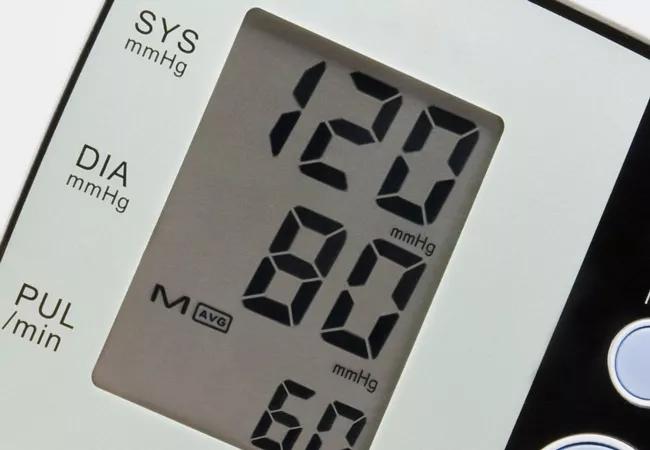Home transmission to the medical record, plus ambulatory monitoring for high-risk patients

While most large academic centers number their 24-hour ambulatory blood pressure monitoring (ABPM) studies in the dozens per year, Cleveland Clinic completed more than 100 such studies in 2019 and is on pace to double that number in 2020. As the gold standard for out-of-office BP measurement, the studies are a priority for Luke Laffin, MD, Director of the Ambulatory Blood Pressure Monitoring Program in Cleveland Clinic’s Department of Preventive Cardiology and Rehabilitation.
Advertisement
Cleveland Clinic is a non-profit academic medical center. Advertising on our site helps support our mission. We do not endorse non-Cleveland Clinic products or services. Policy
Beyond helping clinicians refine management of the individual patients being studied, the growing program also is yielding an abundance of data to help address research questions and identify new avenues for study. Two such resulting investigations are profiled below.
An often-overlooked group for treatment of high BP includes patients with “masked hypertension,” those who have normal BP measurements in the doctor’s office but elevated pressures otherwise. This entity can be subdivided into two categories:
The conditions are detectable using either home BP monitoring or ABPM; the latter is the preferred method for better sensitivity but requires more resources.
“Masked and masked-uncontrolled hypertension are not benign, as they increase the risk of cardiovascular disease,” emphasizes Dr. Laffin, who leads the study. “Identifying patients with these conditions is critical to either initiate blood pressure control or provide more aggressive hypertension treatment.”
Study design. The Screening During Cardiac Rehabilitation for Masked Hypertension with Ambulatory Blood Pressure Monitoring (SCREAM-ABPM) trial is assessing the prevalence of masked and masked-uncontrolled hypertension among patients participating in a Cleveland Clinic phase II cardiac rehabilitation outpatient program. This prospective cross-sectional study is enrolling 200 consecutive participants ages 30 to 80 years with systolic BP (measured during a cardiac rehabilitation visit) between 115 and 130 mmHg and diastolic BP less than 80 mmHg.
Advertisement
Each patient undergoes 24-hour ABPM, and results are analyzed using American Heart Association/American College of Cardiology 2017 and European Society of Cardiology 2018 blood pressure guidelines as thresholds for defining hypertension.
The primary endpoint is the combined prevalence of masked and masked-uncontrolled HTN.
Implications and future research. Dr. Laffin says he knows of no other study that has tried to assess the prevalence of these conditions among patients in cardiac rehabilitation. He hypothesizes that the research team will identify the conditions in more than 10% of the study cohort.
“Assessing the prevalence of ‘hidden’ hypertension has wide-ranging implications for cardiac rehabilitation,” he says. “If it turns out to be a significant issue, screening this high-risk group with 24-hour ABPM may become the standard of care.”
In the future, Dr. Laffin’s group plans to compare ABPM findings with home BP monitoring in a similar cohort.
Patients with a type B aortic dissection who do not receive surgical intervention are discharged on medical therapy consisting of strict BP control (systolic 100-120 mmHg). Too often, however, follow-up appointments reveal that patients are unable to achieve this goal.
“Finding ways for patients with type B aortic dissection to better manage their blood pressure is a continual challenge,” says Cleveland Clinic’s Section Head of Clinical Cardiology, Venu Menon, MD.
Dr. Menon is principal investigator of the Digital Home Blood Pressure Monitoring in Type B Aortic Dissection Patients (DISSECT-BP) study, which is evaluating the effectiveness of home digital BP monitoring with regular physician oversight in this population after hospital discharge.
Advertisement
Study design.The prospective DISSECT-BP study is enrolling 100 patients who present to Cleveland Clinic with either a type B aortic dissection or intramural hematoma and receive no surgical intervention during the index hospitalization. Patients are randomized to one of two groups:
Patients in both groups undergo 24-hour ABPM at the start of the study and again at four weeks, when they also have an office visit. The goal of medical therapy in all cases is to achieve a systolic blood pressure of 100 to 120 mmHg.
The primary endpoint is the change in mean 24-hour systolic BP between the start and end of the study. Secondary endpoints assessed at four weeks will be:
Implications. Although previous studies have shown that patients who receive pharmacist adjustment of medications based on home BP monitoring have better-controlled BP, individual devices have not been validated in well-designed clinical trials such as this one, according to Dr. Laffin, who is a study co-investigator.
Advertisement
“If we demonstrate the value of this system, it has implications for home management of a variety of high-risk conditions for which strict blood pressure control is especially critical,” he concludes.
Advertisement
Advertisement

End-of-treatment VALOR-HCM analyses reassure on use in women, suggest disease-modifying potential

New Cleveland Clinic data challenge traditional size thresholds for surgical intervention

3 specialists share multidisciplinary perspectives on a widely impactful cardiovascular condition

Experience-based takes on valve-sparing root replacement from two expert surgeons

Two surgeons share insights on weighing considerations across the lifespan

Join us in Florida this winter for a long-standing CME favorite

BITA grafts themselves are rarely to blame, and outcomes can be good

First-in-human phase 1 trial induced loss of function in gene that codes for ANGPTL3